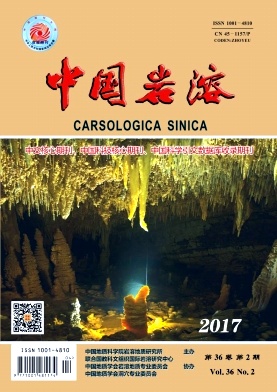TANG Yuan, LIAN Bin, CHENG Jianzhong. Archaeal community structure and diversity of the carbonate rocks in karst regions, Guizhou:A case study of the Nanjiang canyon[J]. Carsologica Sinica, 2017, (2): 193-201. doi: 10.11932/karst20170206
| Citation: |
TANG Yuan, LIAN Bin, CHENG Jianzhong. Archaeal community structure and diversity of the carbonate rocks in karst regions, Guizhou:A case study of the Nanjiang canyon[J]. Carsologica Sinica, 2017, (2): 193-201. doi: 10.11932/karst20170206
|
Archaeal community structure and diversity of the carbonate rocks in karst regions, Guizhou:A case study of the Nanjiang canyon
-
Abstract
Guizhou is one of the three largest karst regions in the world where vast expanses of karst develop well.The carbonate rock area is 13× 104 km2,covering 73% of total land surface area of the province.Carbonate rock is very challenging for organisms to live in it owing to its features,such as arid environment,nutritional deficiency,and great temperature fluctuations.However,there are various microorganisms on its surface and in its cracks,which play a crucial role in biogeochemical cycle.The Nanjiang canyon is a typical karst canyon,which is praised as "Karst Ecosystem Museum".It is located in Kaiyang County of Guizhou Province,southwestern China.And there are a lot of exposed carbonate rocks in this area.In order to study the archaeal diversity of carbonate rocks in Guizhou karst areas,we investigated the archaeal community structure in dolomite and limestone rocks from Nanjiang canyon using 16S rDNA gene clone libraries combined with Restriction Fragment Length Polymorphism (RFLP) analysis.Genomic DNA of rock samples were collected using the UltraCleanTM Soil DNA Isolation Kit.PCR amplification of the archaeal 16S rRNA gene was performed using universal primers 27F and 958R.The PCR products were ligated into the pGEMT Easy Vector System Ⅰ and transformed into competent E.coli JM109 cells and then constructed the dolomite and limestone clone libraries.Randomly selected 300 positive clones from each clone library were identified by RFLP with restriction endonuclease Msp Ⅰ.In total,14 and 13 genotypes were obtained from dolomite and limestone clone libraries,respectively.The rarefaction curves indicate that the major part of the di versity in the clone libraries was covered.The coverage C values of dolomite and limestone clone libraries are 95.4% and 91.3%,and Shannon-Wiener indexes are 2.14 and 1.93,respectively.The diversity of indexes shows that the diversity of archaea is much lower than the bacterial and fungal diversity,and the archaeal diversity of dolomite is slightly higher than that of limestone.The phylogenetic analysis reveals that all clones from the two clone libraries are affiliated to the phylum Crenarchaeota.The similarities between the representative clone sequences from carbonate rocks and their closest sequences deposited in GenBank range from 96% to 100% and all of the matches are from uncultured archaeal clones.Meanwhile,most of the archaeal sequences are closely related to environmental clones from soil and rock environments.
-

-
-
Access History







 DownLoad:
DownLoad: